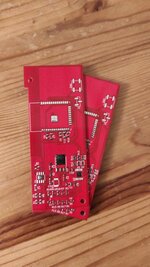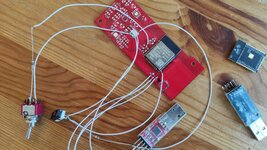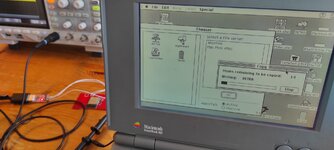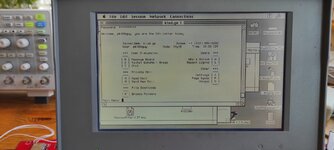twelvetone12
Well-known member
I recently restored a PowerBook 100 and I was thinking that it would be very cool if it could connect to LocalTalk without cables, basically to have an AirTalk integrated. I realised that the internal modem port is unused (I imagine for the most part nowadays!) - what if I could condense @cheesestraws's AirTalk to a small board and fit it there?
Well, here is the integrated AirTalk for PB 100 series. I'm opening this thread to share my project with the community and see if somebody else may be interested
The idea is this: fit the AirTalk on the modem board and connect it to the modem port. To make it work it needs a patch (I am working on and INIT and a CDEV) to turn on the modem power, and then in the Networking control panel one can select Modem for LocalTalk. I tried it with a TashTalk and an USB adapter and it work beautifully, so I imagine that it should work too with the ESP32.
At this stage I finished the first schematic - which is full of jumpers (all the 0 ohms) so I can test various configurations. Since the board will be buried under the keyboard the LEDs are obscured, so I want to see if I can read the status line in software and show the status in the system. The same goes for the ESP reset, I included a button that will be aligned with the external modem port connector, but ideally also usable via software. I will see if I can make it work
This repo contains all my work until now: https://bitbucket.org/twelvetone12/portable_airtalk/ , and I'm attaching the current schematic. I'm working on the PCB layout so hopefully I can have a prototype soon.
For the moment I can only test it with the PB 100, but I would be interested in trying it out with other 1xx series too!
As usual, comments are welcome!
Well, here is the integrated AirTalk for PB 100 series. I'm opening this thread to share my project with the community and see if somebody else may be interested
The idea is this: fit the AirTalk on the modem board and connect it to the modem port. To make it work it needs a patch (I am working on and INIT and a CDEV) to turn on the modem power, and then in the Networking control panel one can select Modem for LocalTalk. I tried it with a TashTalk and an USB adapter and it work beautifully, so I imagine that it should work too with the ESP32.
At this stage I finished the first schematic - which is full of jumpers (all the 0 ohms) so I can test various configurations. Since the board will be buried under the keyboard the LEDs are obscured, so I want to see if I can read the status line in software and show the status in the system. The same goes for the ESP reset, I included a button that will be aligned with the external modem port connector, but ideally also usable via software. I will see if I can make it work
This repo contains all my work until now: https://bitbucket.org/twelvetone12/portable_airtalk/ , and I'm attaching the current schematic. I'm working on the PCB layout so hopefully I can have a prototype soon.
For the moment I can only test it with the PB 100, but I would be interested in trying it out with other 1xx series too!
As usual, comments are welcome!




